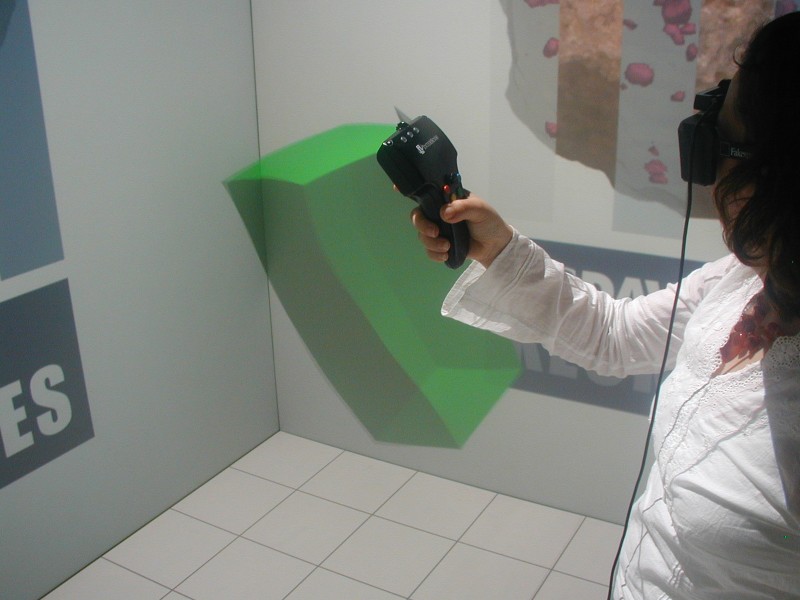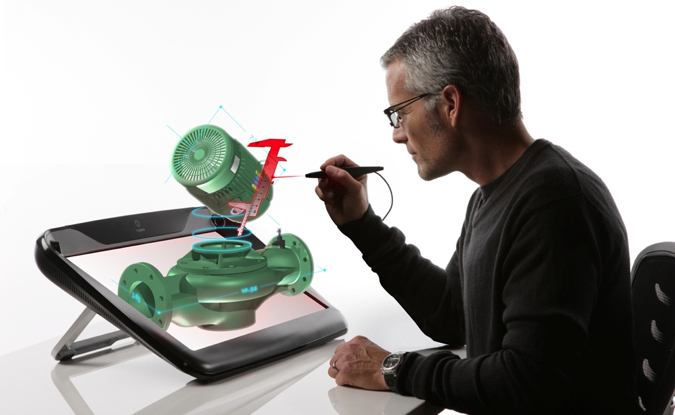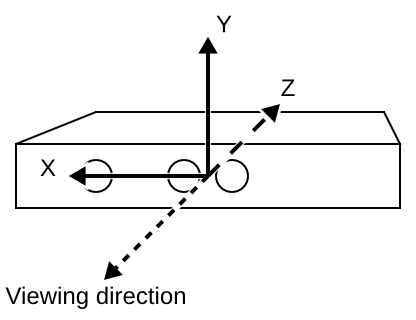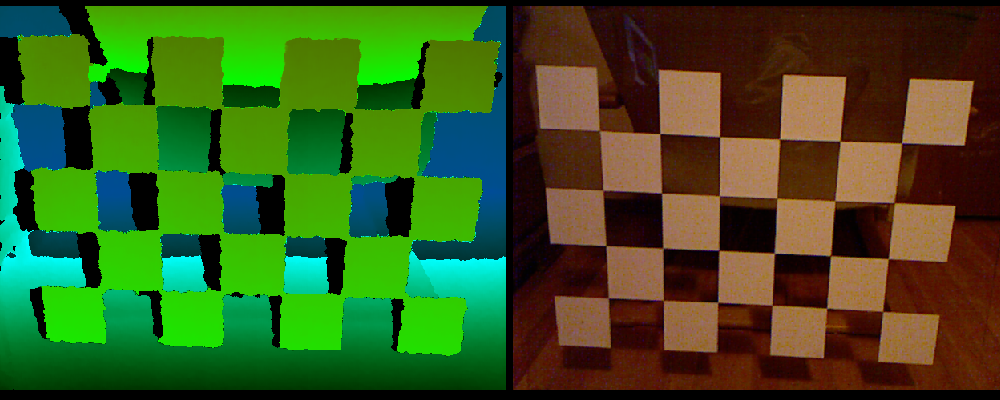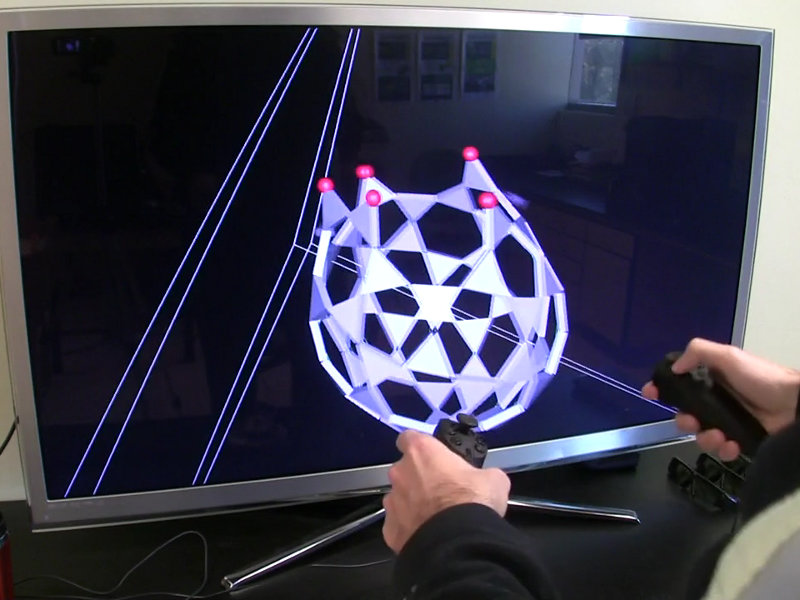I’ve talked about “holographic displays” a lot, most recently in my analysis of the upcoming zSpace display. What I haven’t talked about is how exactly such holographic displays work, what makes them “holographic” as opposed to just stereoscopic, and why that is a big deal.
Monthly Archives: January 2013
ZSpace: a turn-key holographic display
I’ve been waiting for this for such a long time: a turn-key stereoscopic display with built-in pre-calibrated head tracking and tracked input device. We’ve been in the low-cost VR business for more than four years now, but the biggest problem is that our reference design is entirely DIY. Users have to go out and buy individual components, assemble them, and then — most importantly — calibrate them with respect to each other. This calibration step is the biggest hurdle for low-cost VR’s acceptance, because the idea behind it is somewhat hard to understand for VR non-experts, and even if it’s understood, it still requires expensive non-standard tools.
The solution, of course, is simple: instead of having the display and tracking system as separate entities that need to be calibrated with respect to each other, integrate them into the same frame, and pre-calibrate them at the factory. The only thing that had to happen was for a manufacturer to step up to the plate and make it so.
Voilá, I present the zSpace holographic display (see Figure 1).
Continue reading
Kinect factory calibration
Boy, is my face red. I just uploaded two videos about intrinsic Kinect calibration to YouTube, and wrote two blog posts about intrinsic and extrinsic calibration, respectively, and now I find out that the factory calibration data I’ve always suspected was stored in the Kinect’s non-volatile RAM has actually been reverse-engineered. With the official Microsoft SDK out that should definitely not have been a surprise. Oh, well, my excuse is I’ve been focusing on other things lately.
So, how good is it? A bit too early to tell, because some bits and pieces are still not understood, but here’s what I know already. As I mentioned in the post on intrinsic calibration, there are several required pieces of calibration data:
- 2D lens distortion correction for the color camera.
- 2D lens distortion correction for the virtual depth camera.
- Non-linear depth correction (caused by IR camera lens distortion) for the virtual depth camera.
- Conversion formula from (depth-corrected) raw disparity values (what’s in the Kinect’s depth frames) to camera-space Z values.
- Unprojection matrix for the virtual depth camera, to map depth pixels out into camera-aligned 3D space.
- Projection matrix to map lens-corrected color pixels onto the unprojected depth image.
GPU performance: Nvidia Quadro vs Nvidia GeForce
One of the mysteries of the modern age is the existence of two distinct lines of graphics cards by the two big manufacturers, Nvidia and ATI/AMD. There are gamer-level cards, and professional-level cards. What are their differences? Obviously, gamer-level cards are cheap, because the companies face stiff competition from each other, and want to sell as many of them as possible to make a profit. So, why are professional-level cards so much more expensive? For comparison, an “entry-level” $700 Quadro 4000 is significantly slower than a $530 high-end GeForce GTX 680, at least according to my measurements using several Vrui applications, and the closest performance-equivalent to a GeForce GTX 680 I could find was a Quadro 6000 for a whopping $3660. Granted, the Quadro 6000 has 6GB of video RAM to the GeForce’s 2GB, but that doesn’t explain the difference.
Multi-Kinect camera calibration
Intrinsic camera calibration, as I explained in a previous post, calculates the projection parameters of a single Kinect camera. This is sufficient to reconstruct color-mapped 3D geometry in a precise physical coordinate system from a single Kinect device. Specifically, after intrinsic calibration, the Kinect reconstructs geometry in camera-fixed Cartesian space. This means that, looking along the Kinect’s viewing direction, the X axis points to the right, the Y axis points up, and the negative Z axis points along the viewing direction (see Figure 1). The measurement unit for this coordinate system is centimeters.
Kinect camera calibration
I finally managed to upload a pair of tutorial videos showing how to use the new grid-based intrinsic calibration procedure for the Kinect camera. The procedure made it into the Kinect package at least 1.5 years ago, but somehow I never found the time to explain it properly. Oh well. Here are the videos: Intrinsic Kinect Camera Calibration with Semi-transparent Grid and Intrinsic Kinect Camera Calibration Check.
Slow approval of / replies to comments
Aside
I’d like to apologize in advance to everyone who posts a comment here. While I very much appreciate them, and will approve them and reply to them as quickly as I can, my blog has recently been discovered by link farmers, and I am getting a HUGE amount of comment spam. So please be patient as I’m trying to remedy the situation. Thanks!
Low-cost 3D displays using Razer Hydra devices
I’ve previously written about our low-cost VR environments based on 3D TVs and optical tracking. While “low-cost” compared to something like a CAVE, they are still not exactly cheap (around $7000 all told), and not exactly easy to install.
What I haven’t mentioned before is that we have an even lower-cost, and, more importantly, easier to install, alternative using just a 3D TV and a Razer Hydra gaming input device. These environments are not holographic because they don’t have head tracking, but they are still very usable for a large variety of 3D applications. We have several of these systems in production use, and demonstrated them to the public twice, in our booth at the 2011 and 2012 AGU fall meetings. What we found there is that the environments are very easy to use; random visitors walking into our booth and picking up the controllers were able to control fairly complex software in a matter of minutes.
KeckCAVES on Mars, pt. 3
Yesterday, Wednesday, 01/09/2013, Michael Meyer, the lead scientist on NASA’s Mars exploration mission, which includes the ongoing Curiosity rover mission, visited UC Davis as a guest of Dawn Sumner‘s, the KeckCAVES scientist working on that same mission. Dr. Meyer held a seminar in the Geology department, and also gave an interview to one of our local newspapers, the Sacramento Bee.
As part of this visit, Dawn showed him the CAVE, and the Mars-related visualization work we have been doing, including Crusta Mars and our preliminary work with a highly detailed 3D model of the Curiosity rover.
I’m still on vacation, so I missed the visit. Bummer. 🙁
Downloading earthquake datasets for ShowEarthModel
ShowEarthModel is one of the example programs shipped with the Vrui VR development toolkit. It draws a simple texture-mapped virtual globe, and can be used to visualize global geophysical data sets — specifically those containing subsurface data, as the globe can be drawn transparently. However, ShowEarthModel is not packaged with any data sets, primarily to keep the download size small, but also for licensing reasons. Out of the box, it only contains a fairly low-resolution color-mapped Earth topography texture (which can be changed, but that’s a topic for another post).
Since it’s one of the most common requests, here are the steps to download up-to-date earthquake data from the ANSS online catalog:

